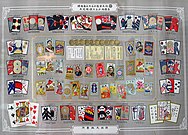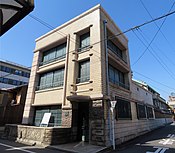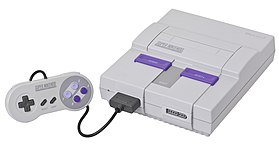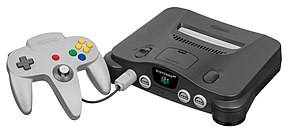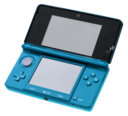
A | B | C | D | E | F | G | H | CH | I | J | K | L | M | N | O | P | Q | R | S | T | U | V | W | X | Y | Z | 0 | 1 | 2 | 3 | 4 | 5 | 6 | 7 | 8 | 9
 Logo used since 2016 | |
 Headquarters in Kyoto, Japan | |
| Nintendo | |
Native name | 任天堂株式会社 |
Romanized name | Nintendō kabushiki gaisha |
| Formerly |
|
| Company type | Public |
| |
| ISIN | JP3756600007 |
| Industry | |
| Founded | 23 September 1889 in Shimogyō-ku, Kyoto, Japan |
| Founder | Fusajiro Yamauchi |
| Headquarters | 11–1 Kamitoba Hokodatecho, , Japan |
Area served | Worldwide |
Key people |
|
| Products | List of products |
Production output |
|
| Brands | Video game series
|
| Services | |
| Revenue | |
| Total assets | |
| Total equity | |
| Owners | |
Number of employees | 7,724[a] (2024) |
| Divisions | |
| Subsidiaries | |
| Website | nintendo |
| Footnotes / references [3][4][5][6][7] | |
Nintendo Co., Ltd.[b] is a Japanese multinational video game company headquartered in Kyoto. It develops, publishes and releases both video games and video game consoles.
Nintendo was founded in 1889 as Nintendo Koppai[c] by craftsman Fusajiro Yamauchi and originally produced handmade hanafuda playing cards. After venturing into various lines of business during the 1960s and acquiring a legal status as a public company, Nintendo distributed its first console, the Color TV-Game, in 1977. It gained international recognition with the release of Donkey Kong in 1981 and the Nintendo Entertainment System and Super Mario Bros. in 1985.
Since then, Nintendo has produced some of the most successful consoles in the video game industry, such as the Game Boy, the Super Nintendo Entertainment System, the Nintendo DS, the Wii, and the Switch. It has created and/or published numerous major franchises, including Mario, Donkey Kong, The Legend of Zelda, Metroid, Fire Emblem, Kirby, Star Fox, Pokémon, Super Smash Bros., Animal Crossing, Xenoblade Chronicles, and Splatoon, and Nintendo's mascot, Mario, is internationally recognized. The company has sold more than 5.592 billion video games and over 836 million hardware units globally, as of March 2023.
Nintendo has multiple subsidiaries in Japan and abroad, in addition to business partners such as HAL Laboratory, Intelligent Systems, Game Freak, and The Pokémon Company. Nintendo and its staff have received awards including Emmy Awards for Technology & Engineering, Game Awards, Game Developers Choice Awards, and British Academy Games Awards. It is one of the wealthiest and most valuable companies in the Japanese market.
History
1889–1972: Early history
1889–1932: Origin as a playing card business
Nintendo was founded as Nintendo Koppai[d] on 23 September 1889[8] by craftsman Fusajiro Yamauchi in Shimogyō-ku, Kyoto, Japan, as an unincorporated establishment, to produce and distribute Japanese playing cards, or karuta (かるた, from Portuguese carta, 'card'), most notably hanafuda (花札, 'flower cards').[3][4][5][9][10][11] The name "Nintendo" is commonly assumed to mean "leave luck to heaven",[12][11] but the assumption lacks historical validation; it has also been suggested to mean "the temple of free hanafuda", but even descendants of Yamauchi do not know the true intended meaning of the name.[9] Hanafuda cards had become popular after Japan banned most forms of gambling in 1882, though tolerated hanafuda. Sales of hanafuda cards were popular with the yakuza-run gaming parlors in Kyoto. Other card manufacturers had opted to leave the market not wanting to be associated with criminal ties, but Yamauchi persisted without such fears to become the primary producer of hanafuda within a few years.[13] With the increase of the cards' popularity, Yamauchi hired assistants to mass-produce to satisfy the demand.[14] Even with a favorable start, the business faced financial struggle due to operating in a niche market, the slow and expensive manufacturing process, high product price, alongside long durability of the cards, which impacted sales due to the low replacement rate.[15] As a solution, Nintendo produced a cheaper and lower-quality line of playing cards, Tengu, while also conducting product offerings in other cities such as Osaka, where card game profits were high. In addition, local merchants were interested in the prospect of a continuous renewal of decks, thus avoiding the suspicions that reusing cards would generate.[16]
According to Nintendo, the business' first western-style card deck was put on the market in 1902,[4][5] although other documents postpone the date to 1907, shortly after the Russo-Japanese War.[17] Although the cards were initially meant for export, they quickly gained popularity not only abroad but also in Japan.[4][5] During this time, the business styled itself as Marufuku Nintendo Card Co.[18] The war created considerable difficulties for companies in the leisure sector, which were subject to new levies such as the Karuta Zei ("playing cards tax").[19] Nintendo subsisted and, in 1907, entered into an agreement with Nihon Senbai—later known as the Japan Tobacco—to market its cards to various cigarette stores throughout the country.[20] A Nintendo promotional calendar from the Taishō era dated to 1915 indicates that the business was named Yamauchi Nintendo[e] but still used the Marufuku Nintendo Co. brand for its playing cards.[21]
Japanese culture stipulated that for Nintendo to continue as a family business after Yamauchi's retirement, Yamauchi had to adopt his son-in-law so that he could take over the business. As a result, Sekiryo Kaneda adopted the Yamauchi surname in 1907 and headed the business in 1929. By that time, Nintendo was the largest playing card business in Japan.[22]
1933–1968: Incorporation, expansion, and diversification
In 1933, Sekiryo Kaneda established the company as a general partnership named Yamauchi Nintendo & Co., Ltd.[f][5] investing in the construction of a new corporate headquarters located next to the original building,[23] near the Toba-kaidō train station.[24] Because Sekiryo's marriage to Yamauchi's daughter produced no male heirs, he planned to adopt his son-in-law Shikanojo Inaba, an artist in the company's employ and the father of his grandson Hiroshi, born in 1927. However, Inaba abandoned his family and the company, so Hiroshi was made Sekiryo's eventual successor.[25]
World War II negatively impacted the company as Japanese authorities prohibited the diffusion of foreign card games, and as the priorities of Japanese society shifted, its interest in recreational activities waned. During this time, Nintendo was partly supported by a financial injection from Hiroshi's wife Michiko Inaba, who came from a wealthy family.[26] In 1947, Sekiryo founded the distribution company Marufuku Co., Ltd.[g] responsible for Nintendo's sales and marketing operations, which would eventually go on to become the present-day Nintendo Co., Ltd., in Higashikawara-cho, Imagumano, Higashiyama-ku, Kyoto.[4][5][9]
In 1950, due to Sekiryo's deteriorating health,[27] Hiroshi Yamauchi assumed the presidency and headed manufacturing operations.[4][5] His first actions involved several important changes in the operation of the company: in 1951, he changed the company name to Nintendo Playing Card Co., Ltd.[h][4][5][28] and in the following year, he centralized the manufacturing facilities dispersed in Kyoto, which led to the expansion of the offices in Kamitakamatsu-cho, Fukuine, Higashiyama-ku, Kyoto.[4][5][29] In 1953, Nintendo became the first company to succeed in mass-producing plastic playing cards in Japan.[4][5] Some of the company's employees, accustomed to a more cautious and conservative leadership, viewed the new measures with concern, and the rising tension led to a call for a strike. However, the measure had no major impact, as Hiroshi resorted to the dismissal of several dissatisfied workers.[30]
In 1959, Nintendo moved its headquarters to Kamitakamatsu-cho, Fukuine, Higashiyama-ku, Kyoto. The company entered into a partnership with The Walt Disney Company to incorporate its characters into playing cards, which opened it up to the children's market and resulted in a boost to Nintendo's playing card business.[4][5][28] Nintendo automated the production of Japanese playing cards using backing paper, and also developed a distribution system that allowed it to offer its products in toy stores.[4][23] By 1961, the company had established a Tokyo branch in Chiyoda, Tokyo,[4] and sold more than 1.5 million card packs, holding a high market share, for which it relied on televised advertising campaigns.[31] In 1962, Nintendo became a public company by listing stock on the second section of the Osaka Securities Exchange and on the Kyoto Stock Exchange.[4][5] In the following year, the company adopted its current name, Nintendo & Co., Ltd.[i] and started manufacturing games in addition to playing cards.[4][5]
In 1964, Nintendo earned ¥150 million.[32] Although the company was experiencing a period of economic prosperity, the Disney cards and derived products made it dependent on the children's market. The situation was exacerbated by the falling sales of its adult-oriented playing cards caused by Japanese society gravitating toward other hobbies such as pachinko, bowling, and nightly outings.[31] When Disney card sales began to decline, Nintendo realized that it had no real alternative to alleviate the situation.[32] After the 1964 Tokyo Olympics, Nintendo's stock price plummeted to its lowest recorded level of ¥60.[33][34]
In 1965, Nintendo hired Gunpei Yokoi to maintain the assembly-line machines used to manufacture its playing cards.[35]
1969–1972: Classic and electronic toys
Yamauchi's experience with the previous initiatives led him to increase Nintendo's investment in a research and development department in 1969, directed by Hiroshi Imanishi, a long-time employee of the company.[5] Yokoi was moved to the newly created department and was responsible for coordinating various projects.[23] Yokoi's experience in manufacturing electronic devices led Yamauchi to put him in charge of the company's games department, and his products would be mass-produced.[36] During this period, Nintendo built a new production plant in Uji, just outside of Kyoto,[5] and distributed classic tabletop games such as chess, shogi, go, and mahjong, and other foreign games under the Nippon Game brand.[37] The company's restructuring preserved a couple of areas dedicated to playing card manufacturing.[38]
In 1970, the company's stock listing was promoted to the first section of the Osaka Stock Exchange,[4][5] and the reconstruction and enlargement of its corporate headquarters was completed.[5] The year represented a watershed moment in Nintendo's history as it released Japan's first electronic toy—the Beam Gun, an optoelectronic pistol designed by Masayuki Uemura.[5] In total, more than a million units were sold.[23] Nintendo partnered with Magnavox to provide a light gun controller based on the Beam Gun design for the company's new home video game console, the Magnavox Odyssey, in 1971.[39] Other popular toys released at the time included the Ultra Hand, the Ultra Machine, the Ultra Scope, and the Love Tester, all designed by Yokoi. More than 1.2 million units of Ultra Hand were sold in Japan.[14]
1973–present: History in electronics
1973–1978: Early video games and Color TV-Game

The growing demand for Nintendo's products led Yamauchi to further expand the offices, for which he acquired the surrounding land and assigned the production of cards to the original Nintendo building. Meanwhile, Yokoi, Uemura, and new employees such as Genyo Takeda, continued to develop innovative products for the company.[23] The Laser Clay Shooting System was released in 1973 and managed to surpass bowling in popularity. Though Nintendo's toys continued to gain popularity, the 1973 oil crisis caused both a spike in the cost of plastics and a change in consumer priorities that put essential products over pastimes, and Nintendo lost several billion yen.[40]
In 1974, Nintendo released Wild Gunman, a skeet shooting arcade simulation consisting of a 16 mm image projector with a sensor that detects a beam from the player's light gun. Both the Laser Clay Shooting System and Wild Gunman were successfully exported to Europe and North America.[5] However, Nintendo's production speeds were still slow compared to rival companies such as Bandai and Tomy, and their prices were high, which led to the discontinuation of some of their light gun products.[41] The subsidiary Nintendo Leisure System Co., Ltd., which developed these products, was closed as a result of the economic impact dealt by the oil crisis.[42]
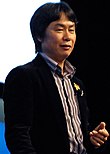
Yamauchi, motivated by the successes of Atari and Magnavox with their video game consoles,[23] acquired the Japanese distribution rights for the Magnavox Odyssey in 1974,[36] and reached an agreement with Mitsubishi Electric to develop similar products between 1975 and 1978, including the first microprocessor for video games systems, the Color TV-Game series, and an arcade game inspired by Othello.[5] During this period, Takeda developed the video game EVR Race,[43] and Shigeru Miyamoto joined Yokoi's team with the responsibility of designing the casing for the Color TV-Game consoles.[44] In 1978, Nintendo's research and development department was split into two facilities, Nintendo Research & Development 1 and Nintendo Research & Development 2, respectively managed by Yokoi and Uemura.[45][46]
Shigeru Miyamoto brought distinctive sources of inspiration, including the natural environment and regional culture of Sonobe, popular culture influences like Westerns and detective fiction, along with folk Shinto practices and family media.[47][48][49][50] These would each be seen in most of Nintendo's major franchises which developed following Miyamoto's creative leadership.[51]
1979–1987: Game and Watch, arcade games, and Nintendo Entertainment System
Two key events in Nintendo's history occurred in 1979: its American subsidiary was opened in New York City, and a new department focused on arcade game development was created. In 1980, one of the first handheld video game systems, the Game & Watch, was created by Yokoi from the technology used in portable calculators.[5][40] It became one of Nintendo's most successful products, with over 43.4 million units sold worldwide during its production period, and for which 59 games were made in total.[52]

Nintendo entered the arcade video game market with Sheriff and Radar Scope, released in Japan in 1979 and 1980 respectively. Sheriff, also known as Bandido in some regions, marked the first original video game made by Nintendo, was published by Sega and developed by Genyo Takeda and Shigeru Miyamoto.[51][53][54] Radar Scope rivaled Galaxian in Japanese arcades but failed to find an audience overseas and created a financial crisis for the company.[55] To try to find a more successful game, they put Miyamoto in charge of their next arcade game design, leading to the release of Donkey Kong in 1981, one of the first platform video games that allowed the player character to jump.[56] The character, Jumpman, would later become Mario and Nintendo's official mascot. Mario was named after Mario Segale, the landlord of Nintendo's offices in Tukwila, Washington.[57] Donkey Kong was a financial success for Nintendo both in Japan and overseas, and led Coleco to fight Atari for licensing rights for porting to home consoles and personal computers.[55]
In 1983, Nintendo opened a new production facility in Uji and was listed on the first section of the Tokyo Stock Exchange.[5] Uemura, taking inspiration from the ColecoVision,[58] began creating a new video game console that would incorporate a ROM cartridge format for video games as well as both a central processing unit and a picture processing unit.[5][59][60] The Family Computer, or Famicom, was released in Japan in July 1983 along with three games adapted from their original arcade versions: Donkey Kong, Donkey Kong Jr. and Popeye.[61] Its success was such that in 1984, it surpassed the market share held by Sega's SG-1000.[62] That success also led to Nintendo leaving the Japanese arcade market in late 1985.[63][64] At this time, Nintendo adopted a series of guidelines that involved the validation of each game produced for the Famicom before its distribution on the market, agreements with developers to ensure that no Famicom game would be adapted to other consoles within two years of its release, and restricting developers from producing more than five games per year for the Famicom.[65]
In the early 1980s, several video game consoles proliferated in the United States, as well as low-quality games produced by third-party developers,[66] which oversaturated the market and led to the video game crash of 1983.[67] Consequently, a recession hit the American video game industry, whose revenues went from over $3 billion to $100 million between 1983 and 1985.[68] Nintendo's initiative to launch the Famicom in America was also impacted. To differentiate the Famicom from its competitors in America, Nintendo rebranded it as an entertainment system and its cartridges as Game Paks, and with a design reminiscent of a VCR.[60] Nintendo implemented a lockout chip in the Game Paks for control on its third party library to avoid the market saturation that had occurred in the United States.[69] The result is the Nintendo Entertainment System, or NES, which was released in North America in 1985.[5] The landmark games Super Mario Bros. and The Legend of Zelda were produced by Miyamoto and Takashi Tezuka. Composer Koji Kondo reinforced the idea that musical themes could act as a complement to game mechanics rather than simply a miscellaneous element.[70] Production of the NES lasted until 1995,[71] and production of the Famicom lasted until 2003.[72] In total, around 62 million Famicom and NES consoles were sold worldwide.[73] During this period, Nintendo created a copyright infringement protection in the form of the Official Nintendo Seal of Quality, added to their products so that customers may recognize their authenticity in the market.[74] By this time, Nintendo's network of electronic suppliers had extended to around thirty companies, including Ricoh (Nintendo's main source for semiconductors) and the Sharp Corporation.[23]
1988–1992: Game Boy and Super Nintendo Entertainment System
In 1988, Gunpei Yokoi and his team at Nintendo R&D1 conceived the Game Boy, the first handheld video game console made by Nintendo. Nintendo released the Game Boy in 1989. In North America, the Game Boy was bundled with the popular third-party game Tetris after a difficult negotiation process with Elektronorgtechnica.[75] The Game Boy was a significant success. In its first two weeks of sale in Japan, its initial inventory of 300,000 units sold out, and in the United States, an additional 40,000 units were sold on its first day of distribution.[76] Around this time, Nintendo entered an agreement with Sony to develop the Super Famicom CD-ROM Adapter, a peripheral for the upcoming Super Famicom capable of playing CD-ROMs.[77] However, the collaboration did not last as Yamauchi preferred to continue developing the technology with Philips, which would result in the CD-i,[78] and Sony's independent efforts resulted in the creation of the PlayStation console.[79]
The first issue of Nintendo Power magazine, which had an annual circulation of 1.5 million copies in the United States, was published in 1988.[80] In July 1989, Nintendo held the first Nintendo Space World trade show with the name Shoshinkai for the purpose of announcing and demonstrating upcoming Nintendo products.[81] That year, the first World of Nintendo stores-within-a-store, which carried official Nintendo merchandise, were opened in the United States. According to company information, more than 25% of homes in the United States had an NES in 1989.[80]
In the late 1980s, Nintendo's dominance slipped with the appearance of NEC's PC Engine and Sega's Mega Drive, 16-bit game consoles with improved graphics and audio compared to the NES.[82] In response to the competition, Uemura designed the Super Famicom, which launched in 1990. The first batch of 300,000 consoles sold out in hours.[83] The following year, as with the NES, Nintendo distributed a modified version of the Super Famicom to the United States market, titled the Super Nintendo Entertainment System.[84] Launch games for the Super Famicom and Super NES include Super Mario World, F-Zero, Pilotwings, SimCity, and Gradius III.[85] By mid-1992, over 46 million Super Famicom and Super NES consoles had been sold.[5] The console's life cycle lasted until 1999 in the United States,[86] and until 2003 in Japan.[72]
In March 1990, the first Nintendo World Championship was held, with participants from 29 American cities competing for the title of "best Nintendo player in the world".[80][87] In June 1990, the subsidiary Nintendo of Europe was opened in Großostheim, Germany; in 1993, subsequent subsidiaries were established in the Netherlands (where Bandai had previously distributed Nintendo's products), France, the United Kingdom, Spain, Belgium, and Australia.[5] In 1992, Nintendo acquired a majority stake in the Seattle Mariners baseball team, and sold most of its shares in 2016.[88][89] On July 31, 1992, Nintendo of America announced it would cease manufacturing arcade games and systems.[90][91] In 1993, Star Fox was released, which marked an industry milestone by being the first video game to make use of the Super FX chip.[5]
The proliferation of graphically violent video games, such as Mortal Kombat, caused controversy and led to the creation of the Interactive Digital Software Association and the Entertainment Software Rating Board, in whose development Nintendo collaborated during 1994. These measures also encouraged Nintendo to abandon the content guidelines it had enforced since the release of the NES.[92][93] Commercial strategies implemented by Nintendo during this time include the Nintendo Gateway System, an in-flight entertainment service available for airlines, cruise ships and hotels,[94] and the "Play It Loud!" advertising campaign for Game Boys with different-colored casings. The Advanced Computer Modeling graphics used in Donkey Kong Country for the Super NES and Donkey Kong Land for the Game Boy were technologically innovative, as was the Satellaview satellite modem peripheral for the Super Famicom, which allowed the digital transmission of data via a communications satellite in space.[5]
1993–1998: Nintendo 64, Virtual Boy, and Game Boy Color
In mid-1993, Nintendo and Silicon Graphics announced a strategic alliance to develop the Nintendo 64.[95][96] NEC, Toshiba, and Sharp also contributed technology to the console.[97] The Nintendo 64 was marketed as one of the first consoles to be designed with 64-bit architecture.[98] As part of an agreement with Midway Games, the arcade games Killer Instinct and Cruis'n USA were ported to the console.[99][100] Although the Nintendo 64 was planned for release in 1995, the production schedules of third-party developers influenced a delay,[101][102] and the console was released in June 1996 in Japan, September 1996 in the United States and March 1997 in Europe. By the end of its production in 2002, around 33 million Nintendo 64 consoles were sold worldwide,[73] and it is considered one of the most recognized video game systems in history.[103] 388 games were produced for the Nintendo 64 in total,[104] some of which – particularly Super Mario 64, The Legend of Zelda: Ocarina of Time, and GoldenEye 007 – have been distinguished as some of the greatest of all time.[105]

In 1995, Nintendo released the Virtual Boy, a console designed by Gunpei Yokoi with stereoscopic graphics. Critics were generally disappointed with the quality of the games and red-colored graphics, and complained of gameplay-induced headaches.[106] The system sold poorly and was quietly discontinued.[107] Amid the system's failure, Yokoi formally retired from Nintendo.[108] In February 1996, Pocket Monsters Red and Green, known internationally as Pokémon Red and Blue, developed by Game Freak was released in Japan for the Game Boy, and established the popular Pokémon franchise.[109]: 191 The game went on to sell 31.37 million units,[110] with the video game series exceeding a total of 300 million units in sales as of 2017.[111] In 1997, Nintendo released the Rumble Pak, a plug-in device that connects to the Nintendo 64 controller and produces a vibration during certain moments of a game.[5]
In 1998, the Game Boy Color was released. In addition to backward compatibility with Game Boy games, the console's similar capacity to the NES resulted in select adaptations of games from that library, such as Super Mario Bros. Deluxe.[112] Since then, over 118.6 million Game Boy and Game Boy Color consoles have been sold worldwide.[113]
1999–2003: Game Boy Advance and GameCube
In May 1999, with the advent of the PlayStation 2,[114] Nintendo entered an agreement with IBM and Panasonic to develop the 128-bit Gekko processor and the DVD drive to be used in Nintendo's next home console.[115] Meanwhile, a series of administrative changes occurred in 2000, when Nintendo's corporate offices were moved to the Minami-ku neighborhood in Kyoto, and Nintendo Benelux was established to manage the Dutch and Belgian territories.[5]
In 2001, two new Nintendo consoles were introduced: the Game Boy Advance, which was designed by Gwénaël Nicolas with stylistic departure from its predecessors,[116][117] and the GameCube.[118] During the first week of the Game Boy Advance's North American release in June 2001, over 500,000 units were sold, making it the fastest-selling video game console in the United States at the time.[119] By the end of its production cycle in 2010, more than 81.5 million units had been sold worldwide.[113] As for the GameCube, even with such distinguishing features as the miniDVD format of its games and Internet connectivity for a few games,[120][121] its sales were lower than those of its predecessors, and during the six years of its production, 21.7 million units were sold worldwide.[122] The GameCube struggled against its rivals in the market,[123][124] and its initial poor sales led to Nintendo posting a first half fiscal year loss in 2003 for the first time since the company went public in 1962.[125]
In 2002, the Pokémon Mini was released. Its dimensions were smaller than that of the Game Boy Advance and it weighed 70 grams, making it the smallest video game console in history.[5] Nintendo collaborated with Sega and Namco to develop Triforce, an arcade board to facilitate the conversion of arcade titles to the GameCube.[126] Following the European release of the GameCube in May 2002,[127] Hiroshi Yamauchi announced his resignation as the president of Nintendo, and Satoru Iwata was selected by the company as his successor. Yamauchi would remain as advisor and director of the company until 2005,[128] and he died in 2013.[129] Iwata's appointment as president ended the Yamauchi succession at the helm of the company, a practice that had been in place since its foundation.[130][131]
In 2003, Nintendo released the Game Boy Advance SP, an improved version of the Game Boy Advance with a foldable case, an illuminated display, and a rechargeable battery. By the end of its production cycle in 2010, over 43.5 million units had been sold worldwide.[113] Nintendo also released the Game Boy Player, a peripheral that allows Game Boy and Game Boy Advance games to be played on the GameCube.
2004–2009: Nintendo DS and Wii
In 2004, Nintendo released the Nintendo DS, which featured such innovations as dual screens – one of which being a touchscreen – and wireless connectivity for multiplayer play.[5][132] Throughout its lifetime, more than 154 million units were sold, making it the most successful handheld console and the second bestselling console in history.[113] In 2005, Nintendo released the Game Boy Micro, the last system in the Game Boy line.[5][112] Sales did not meet Nintendo's expectations,[133] with 2.5 million units being sold by 2007.[134] In mid-2005, the Nintendo World Store was inaugurated in New York City.[135]

Nintendo's next home console was conceived in 2001, although development commenced in 2003, taking inspiration from the Nintendo DS.[136] Nintendo also considered the relative failure of the GameCube, and instead opted to take a "Blue Ocean Strategy" by developing a reduced performance console in contrast to the high-performance consoles of Sony and Microsoft to avoid directly competing with them.[137] The Wii was released in November 2006,[138] with a total of 33 launch games.[139] With the Wii, Nintendo sought to reach a broader demographic than its seventh-generation competitors,[140] with the intention of also encompassing the "non-consumer" sector.[141] To this end, Nintendo invested in a $200 million advertising campaign.[142] The Wii's innovations include the Wii Remote controller, equipped with an accelerometer system and infrared sensors that allow it to detect its position in a three-dimensional environment with the aid of a sensor bar;[143][144] the Nunchuk peripheral that includes an analog controller and an accelerometer;[145] and the Wii MotionPlus expansion that increases the sensitivity of the main controller with the aid of gyroscopes.[146] By 2016, more than 101 million Wii consoles had been sold worldwide,[147] making it the most successful console of its generation, a distinction that Nintendo had not achieved since the 1990s with the Super NES.[148]
Several accessories were released for the Wii from 2007 to 2010, such as the Wii Balance Board, the Wii Wheel and the WiiWare download service. In 2009, Nintendo Iberica S.A. expanded its commercial operations to Portugal through a new office in Lisbon.[5] By that year, Nintendo held a 68.3% share of the worldwide handheld gaming market.[149] In 2010, Nintendo celebrated the 25th anniversary of Mario's debut appearance, for which certain allusive products were put on sale. The event included the release of Super Mario All-Stars 25th Anniversary Edition and special editions of the Nintendo DSi XL and Wii.[150]
2010–2016: Nintendo 3DS, Wii U, and mobile ventures
Following an announcement in March 2010,[151] Nintendo released the Nintendo 3DS in 2011. The console produces stereoscopic effects without 3D glasses.[152] By 2018, more than 69 million units had been sold worldwide;[153] the figure increased to 75 million by the start of 2019.[147] In 2011, Nintendo celebrated the 25th anniversary of The Legend of Zelda with the orchestra concert tour The Legend of Zelda: Symphony of the Goddesses and the video game The Legend of Zelda: Skyward Sword.[154]
In 2012 and 2013, two new Nintendo game consoles were introduced: the Wii U, with high-definition graphics and a GamePad controller with near-field communication technology,[155][156] and the Nintendo 2DS, a version of the 3DS that lacks the clamshell design of Nintendo's previous handheld consoles and the stereoscopic effects of the 3DS.[157] With 13.5 million units sold worldwide,[147] the Wii U is the least successful video game console in Nintendo's history.[158] In 2014, a new product line was released consisting of figures of Nintendo characters called amiibos.[5]
On 25 September 2013, Nintendo announced its acquisition of a 28% stake in PUX Corporation, a subsidiary of Panasonic, for the purpose of developing facial, voice, and text recognition for its video games.[159] Due to a 30% decrease in company income between April and December 2013, Iwata announced a temporary 50% cut to his salary, with other executives seeing reductions by 20%–30%.[160] In January 2015, Nintendo ceased operations in the Brazilian market due in part to high import duties. This did not affect the rest of Nintendo's Latin American market due to an alliance with Juegos de Video Latinoamérica.[161] Nintendo reached an agreement with NC Games for Nintendo's products to resume distribution in Brazil by 2017,[162] and by September 2020, the Switch was released in Brazil.[163]
On 11 July 2015, Iwata died of bile duct cancer, and after a couple of months in which Miyamoto and Takeda jointly operated the company, Tatsumi Kimishima was named as Iwata's successor on 16 September 2015.[164] As part of the management's restructuring, Miyamoto and Takeda were respectively named creative and technological advisors.[165]
The financial losses caused by the Wii U, along with Sony's intention to release its video games to other platforms such as smart TVs, motivated Nintendo to rethink its strategy concerning the production and distribution of its properties.[166] In 2015, Nintendo formalized agreements with DeNA and Universal Parks & Resorts to extend its presence to smart devices and amusement parks respectively.[167][168][169]

In March 2016, Nintendo's first mobile app for the iOS and Android systems, Miitomo, was released.[170] Since then, Nintendo has produced other similar apps, such as Super Mario Run, Fire Emblem Heroes, Animal Crossing: Pocket Camp, Mario Kart Tour, and Pokémon Go, the last being developed by Niantic and having generated $115 million in revenue for Nintendo.[171] In March 2016, the loyalty program My Nintendo replaced Club Nintendo.[172]
Zdroj:https://en.wikipedia.org?pojem=Nintendo_Australia
Text je dostupný za podmienok Creative Commons Attribution/Share-Alike License 3.0 Unported; prípadne za ďalších podmienok. Podrobnejšie informácie nájdete na stránke Podmienky použitia.
Antropológia
Aplikované vedy
Bibliometria
Dejiny vedy
Encyklopédie
Filozofia vedy
Forenzné vedy
Humanitné vedy
Knižničná veda
Kryogenika
Kryptológia
Kulturológia
Literárna veda
Medzidisciplinárne oblasti
Metódy kvantitatívnej analýzy
Metavedy
Metodika
Text je dostupný za podmienok Creative
Commons Attribution/Share-Alike License 3.0 Unported; prípadne za ďalších
podmienok.
Podrobnejšie informácie nájdete na stránke Podmienky
použitia.
www.astronomia.sk | www.biologia.sk | www.botanika.sk | www.dejiny.sk | www.economy.sk | www.elektrotechnika.sk | www.estetika.sk | www.farmakologia.sk | www.filozofia.sk | Fyzika | www.futurologia.sk | www.genetika.sk | www.chemia.sk | www.lingvistika.sk | www.politologia.sk | www.psychologia.sk | www.sexuologia.sk | www.sociologia.sk | www.veda.sk I www.zoologia.sk


